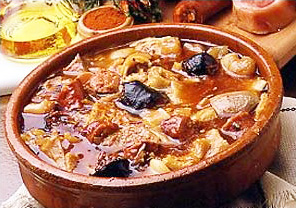

As we have mentioned before, meat is one of the primary products in the Spanish diet, particularly pork, an animal of which nothing is wasted in Spain; the snout, trotters and ears are considered a delicacy now, whereas in the past it was people of humble origins who would eat whatever the wealthy did not want, and turned them into stews. It is there meat stews that have eventually became some of the star dishes of Spanish gastronomy. Whatever was not included in the stews was made into different types of sausages.
But the Spanish were experts in adjusting their meals to their economy, bread crumbs were used to make migas, mixed with different morsels of meats. Other types of stews, such as ollas (pots) were created in the same way: mixing whatever ingredients were left over. Spanish stews tend to contain a mixture of meats and sausages as well as other ingredients. Making a Spanish meat stew is a good way to use up some of the left over ingredients in the fridge, and pretty much anything will go. However, Spanish stews aren't just a throw it all in and see what happens kind of dish. There are some subtleties involved as well, including how to cook certain things, and managing to create the right texture, among other things.
Many also use some kind of legumes, a common and inexpensive ingredient that contributes to give thick texture to the stews. All of the meat stews that you will find here on Spanish food are made from cheap ingredients yet they still produce dishes that are full of flavour and very wholesome. This makes them great options for people who want to try a bit of Spanish cuisine without spending too much money!
Stews are among some of the oldest types of dishes made in the history of man. As soon as early man realised that he could cook things in water over a fire, or by heating rocks and then dropping them in water, the stew became one of the dishes of choice. Stews can incorporate all manner of ingredients, which is probably the reason as to why so many different versions exist in Spain and across the world.
If you decide to study Spanish abroad in Spain we recommend you sample different stews and decide on your favorite! Although many of these stews have humble origins and were often made by the poorest citizens, today they are highly revered and can be found in some of the best restaurants in Spain as well as in the local eateries. However, the best version of these traditional Spanish meat stews is the home-made version!
In fact today, many of these Spanish meat stews are considered to be the epitome of Spanish home cooking and are considered by many people to be great comfort food. Spanish stews tend to be eaten during winter when people want something warm, but something that is also filled with nutrients to help sustain them throughout the cold winter days.
Sadly today, many people have begun to neglect the humble Spanish stews as some can often take a long time to cook. As a result, there are many companies that have begun selling these stews in pre-made and tinned format, hence taking the time and hassle out of making the dish. These are a good option for people who don't have the time to prepare such stews, but they don't compare to a proper, home cooked version!
Below is a list of our pages on some of the most popular meat stews in Spain. On these pages, you will find more information about the history and the origins of these dishes, as well as some quick and simple recipes for you to follow so that you can have a taste of Spanish gastronomy at home.